The GIGABYTE X170-Extreme ECC Motherboard Review: For When Skylake Xeons need SLI and Thunderbolt 3
by Ian Cutress on October 17, 2016 2:00 PM ESTSystem Performance
Not all motherboards are created equal. On the face of it, they should all perform the same and differ only in the functionality they provide - however this is not the case. The obvious pointers are power consumption, but also the ability for the manufacturer to optimize USB speed, audio quality (based on audio codec), POST time and latency. This can come down to manufacturing process and prowess, so these are tested.
Power Consumption
Power consumption was tested on the system while in a single MSI GTX 770 Lightning GPU configuration with a wall meter connected to the OCZ 1250W power supply. This power supply is Gold rated, and as I am in the UK on a 230-240 V supply, leads to ~75% efficiency > 50W, and 90%+ efficiency at 250W, suitable for both idle and multi-GPU loading. This method of power reading allows us to compare the power management of the UEFI and the board to supply components with power under load, and includes typical PSU losses due to efficiency. These are the real world values that consumers may expect from a typical system (minus the monitor) using this motherboard.
While this method for power measurement may not be ideal, and you feel these numbers are not representative due to the high wattage power supply being used (we use the same PSU to remain consistent over a series of reviews, and the fact that some boards on our test bed get tested with three or four high powered GPUs), the important point to take away is the relationship between the numbers. These boards are all under the same conditions, and thus the differences between them should be easy to spot.
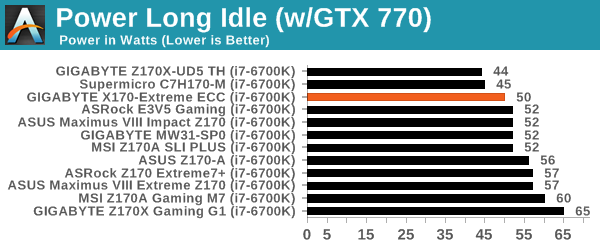
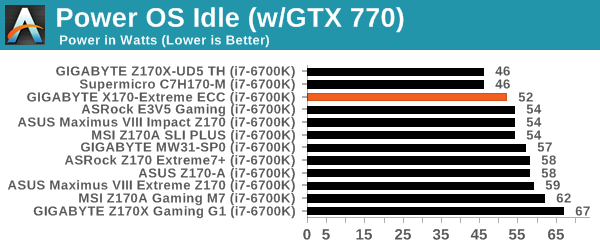

While not the best in any particular power test, I was quite surprised that despite the idle power of the numerous controllers on board, the load power consumption was near one of the best at 133W. This gives a long-idle to load delta of 83, which is in our top five for Skylake-based motherboards.
Non UEFI POST Time
Different motherboards have different POST sequences before an operating system is initialized. A lot of this is dependent on the board itself, and POST boot time is determined by the controllers on board (and the sequence of how those extras are organized). As part of our testing, we look at the POST Boot Time using a stopwatch. This is the time from pressing the ON button on the computer to when Windows 7 starts loading. (We discount Windows loading as it is highly variable given Windows specific features.)
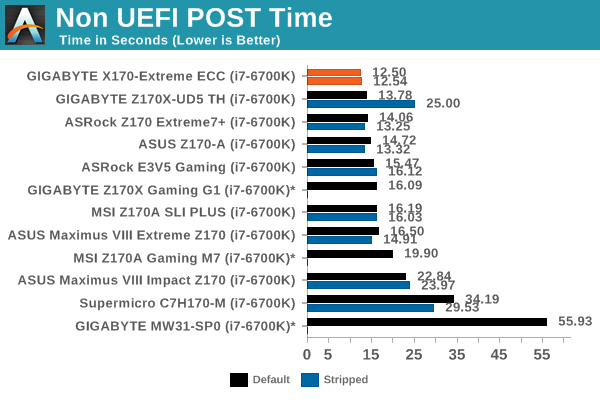
Despite the fact that Skylake-based motherboards are typically slower to POST into Windows 7 than previous generations, and the number of controllers on the GIGABYTE motherboard, we saw a 12.50 second POST time which is the best compared to the other C23x and 100-series motherboards we’ve tested.
Rightmark Audio Analyzer 6.2.5
Rightmark:AA indicates how well the sound system is built and isolated from electrical interference (either internally or externally). For this test we connect the Line Out to the Line In using a short six inch 3.5mm to 3.5mm high-quality jack, turn the OS speaker volume to 100%, and run the Rightmark default test suite at 192 kHz, 24-bit. The OS is tuned to 192 kHz/24-bit input and output, and the Line-In volume is adjusted until we have the best RMAA value in the mini-pretest. We look specifically at the Dynamic Range of the audio codec used on board, as well as the Total Harmonic Distortion + Noise.
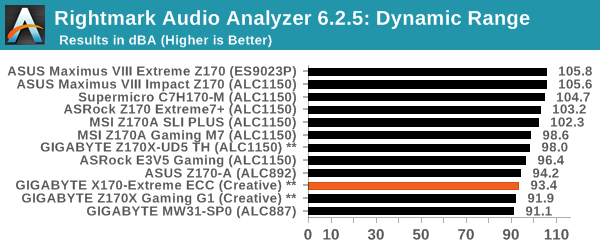
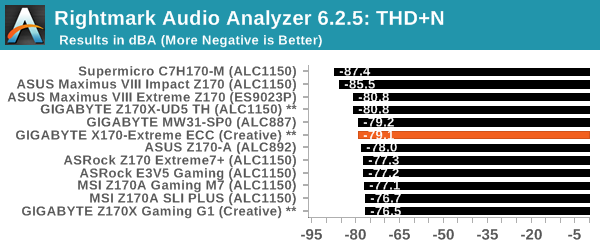
GIGABYTE motherboards of late have been difficult to test. With the speaker volume set to 100%, they cause enough distortion for the results not to matter. Bundle in the Creative audio solutions, and due to the drivers implementing different audio algorithms, it becomes almost possible to test (such as software-based feedback loops giving super-electronic results). We were able to get to a point where we could test this solution, albeit with as many Creative features turned off as possible and speaker volume at 50%, and the results are fairly middling. Given that our test can’t account for the nature of the Creative driver set, it makes this test more of a tick box for utility. Tick.
USB Backup
For this benchmark, we transfer a set size of files from the SSD to the USB drive using DiskBench, which monitors the time taken to transfer. The files transferred are a 1.52 GB set of 2867 files across 320 folders – 95% of these files are small typical website files, and the rest (90% of the size) are small 30 second HD videos. In an update to pre-Z87 testing, we also run MaxCPU to load up one of the threads during the test which improves general performance up to 15% by causing all the internal pathways to run at full speed.
Due to the introduction of USB 3.1, as of June 2015 we are adjusting our test to use a dual mSATA USB 3.1 Type-C device which should be capable of saturating both USB 3.0 and USB 3.1 connections. We still use the same data set as before, but now use the new device. Results are shown as seconds taken to complete the data transfer.
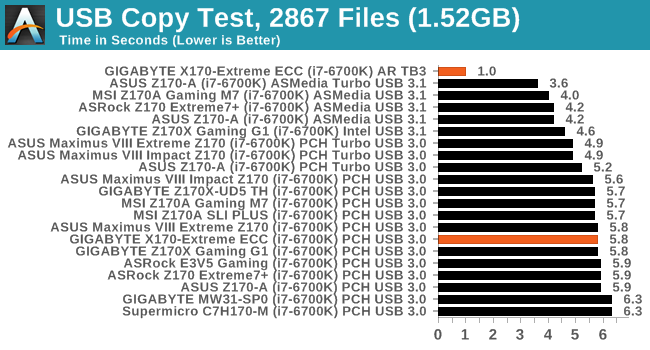
In USB 3.1 mode, Intel’s Alpine Ridge controller frustrates our test – passing a complete command to our software before the data is written, giving a non-deterministic result. Despite that, in TB3 mode using the Akitio Thunder3 PCIe SSD, the results were practically identical. Here’s a good measure of Thunderbolt 3 speed to the right drive: USB 3.0 (5 Gbps) takes 5.8 seconds, whereas active Thunderbolt 3 (40 Gbps to a 32 Gbps drive) takes only 1.0 seconds.
DPC Latency
Deferred Procedure Call latency is a way in which Windows handles interrupt servicing. In order to wait for a processor to acknowledge the request, the system will queue all interrupt requests by priority. Critical interrupts will be handled as soon as possible, whereas lesser priority requests such as audio will be further down the line. If the audio device requires data, it will have to wait until the request is processed before the buffer is filled.
If the device drivers of higher priority components in a system are poorly implemented, this can cause delays in request scheduling and process time. This can lead to an empty audio buffer and characteristic audible pauses, pops and clicks. The DPC latency checker measures how much time is taken processing DPCs from driver invocation. The lower the value will result in better audio transfer at smaller buffer sizes. Results are measured in microseconds.

A score of 250 microseconds here isn’t good. The fact that the motherboards we have results for on this test are in two tiers for Skylake means that there might be some BIOS code implementation for DPC Latency that some vendors have, but others don’t.










31 Comments
View All Comments
Einy0 - Monday, October 17, 2016 - link
I wouldn't say trashy, redneck absolutely...Samus - Monday, October 17, 2016 - link
It isn't a problem with the camo, it works fine on some products and I perhaps think of MSI when I see it since they take such a military angle with their marketing.But a camo theme doesn't belong on a workstation board. It just doesn't. If you want to see what proper workstation boards historically looked like, check out various Supermicro or Asus products, such as the P6T WS. This is a strange angle for gigabyte to take with such an expensive, niche product.
theuglyman0war - Monday, October 17, 2016 - link
I thought the G1 line was originally branded to look military as competition for supposedly military grade competing (sabertooth, tuf ) mB s with a rugged military designs from Asus n MSI?theuglyman0war - Monday, October 17, 2016 - link
like the g1 killer's sniper assasin and guerilla boardsBrokenCrayons - Tuesday, October 18, 2016 - link
That product name...The G1 Killer Sniper Assasin Tactical Assault Special Ops Guerilla ... motherboard. Heh, in the end it always boils down to your mom no matter how "militarized" the motherboard's product name.
blppt - Tuesday, October 18, 2016 - link
Hey, us keyboard commandos need the toughest, baddest, hardcore-est combat ready components!jumjjcmsw - Thursday, November 10, 2016 - link
Come precedentemente riportato qui a iTech Post, ci sono voci su Niantic introducendo eventi Pokemon GO al fine di catturare Pokemon mancante. O forse, faranno cadere questi concerti come un modo per i giocatori di acquisire bonus XP e ricompense. La cosa è quando. Questo è anche lo stesso con l'evento Leggendaria - non ha data precisa stesura di questo documento.http://pokeballsinfinite-pokemongo.blogspot.it/
https://pokemonpokecoinsillimitate.wordpress.com/
http://trucchidipokemongo.weebly.com/
http://tuttosugiochi.tumblr.com/
http://trucchipokemongoillimtiepokecoins.over-blog...
3ogdy - Monday, October 17, 2016 - link
I like this Gigabyte Sabertooth.hubick - Monday, October 17, 2016 - link
I suppose the Thunderbolt port will only output onboard video, and won't let you route DisplayPort from a PCIe graphics card? :-(JeffFlanagan - Monday, October 17, 2016 - link
I suppose it would be good for someone who has a socket 1150 Xeon laying around, and wants to pretend to be in the military while playing games.